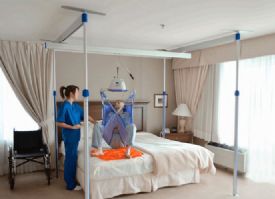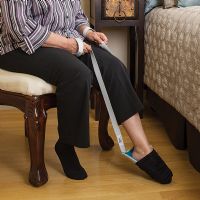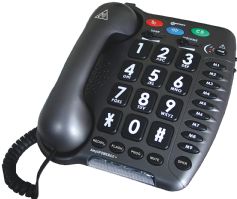~1.jpg&newwidth=80) Written by Jeanine Clancy, MEd, BSN, RN
Written by Jeanine Clancy, MEd, BSN, RN
Nearly 90 percent of adults over 65 would rather age at home than move to a senior living facility. Remaining in their homes allows older adults to manage daily life activities, which leads to greater life satisfaction, better mood, and higher level of overall wellness. Perhaps you’ve spent decades acquiring possessions with sentimental value and developing connections in your community. Aging at home allows you to be surrounded by people and things that have meaning for you.
Safety and comfort are the main considerations for people aging at home. Generally bedrooms don’t need many modifications, and this guide will help you decide what changes would serve you well in your home.
If you have an upstairs bedroom, going up and down the stairs puts you at a greater risk of a fall, which could cause a serious injury. The best solution is to have your bedroom on the first floor, so if you’re still sleeping upstairs, consider converting an existing ground floor room into your sleeping space. You could also add a room onto your house to accommodate a new main floor bedroom. If those options aren’t possible, we recommend installing a stair lift. Check out our Home Stair Lift Buying Guide for benefits and features of these mobility aids that help you safely navigate stairs.
Once you’ve settled on the location of your bedroom, you can survey the space for safety issues.
If you have significant mobility challenges, a home hospital bed can deliver features that make it easier to get positioned comfortably in bed, and get in and out of bed safely. Gone are the days of institutional looking hospital beds. Modern versions have the look of a traditional bed that fits in well with any bedroom decor. Hospital beds are used at home when additional support is needed while entering and exiting the bed, or if a person will need to spend more time in bed than is typical for a night of sleep.
Read our Ultimate Guide to Hospital Beds & Mattresses for Home Care to find out how these beds designed for home use minimize the risk of a fall, make it easier to get in and out of bed, and adjust for comfort and pressure relief. You can also check out Top 5 Adjustable Beds for Seniors for recommendations on top models.
Tripping hazards are common in most homes, and aren’t difficult to remedy. You don’t have to turn your bedroom into a hospital room to be safe. Keep walkways clear, dispose of throw rugs or loose carpeting, and have frequently used items within reach so you don’t have to get up and go looking for them. Decluttering can seem daunting, but it is an essential task when it comes to making a bedroom safe. Relocate in the house, or better yet, pass on to friends and family, anything that is taking up space and not adding value to the space. If you use a wheelchair, walker, scooter, or a cane, you’ll need to allow for enough space around your bed and other furniture to navigate with these assistive devices.
If you are considering a ceiling lift, the first question to answer is if it will be permanently installed in your ceiling or will it use a track that doesn’t require modifying your home.
A ceiling mounted permanent track will require the services of a professional installer. Ceiling tracks come in your choice of premade packages or customized options designed to specifically fit your space. With so many options on the market, read How to Choose the Best Ceiling Patient Lift to make an informed purchasing decision. You can shop all ceiling lifts online, or we’ll be happy to assist you by phone. Just give us a call at 800.827.8283.
.jpg&newwidth=365&maxheight=200) | Free Standing Track and Ceiling Lift Kit by GoLift View Product |
If you are renting your home or don’t want to install a permanent track, free standing tracks provide the flexibility to use a lift on multiple tracks in other areas of your home.
 | EasyTrack 4 Post System - Portable Ceiling Lift by Arjo View Product |
The easiest track system to install pressure fits to the ceiling, and doesn’t require any modifications to your home.
As we age, our senses of sight and sound can be diminished. According to the Lighting Research Center, choosing the lighting for the bedroom of an older adult should include increasing ambient and task light levels, minimizing glare, increasing contrast and improving color perception, and balance illumination levels. Adding lighting solutions like table lamps and floor lamps with efficient bright bulbs illuminates the room so you aren’t startled by things you can’t clearly see in dim light. More room lighting also allows you to better see potential trip hazards in the bedroom, plus fends off headaches that can arise from straining your eyes to see in low light conditions.
Replacing the flooring in your bedroom might seem like a big investment. However, if you are planning to safely age in place, you need to eliminate as many potential dangers as possible, including flooring that could be a hazard. The appropriate flooring mimizes slipping by people and furniture and makes it easy to navigate the room using a wheelchair, scooter, walker, or cane. It should also be easy to maintain and keep clean.
 | Norco Easy-Pull Sock Aids View Product |
A closet organizer can keep your dressing area uncluttered. With everything in an accessible place, you have less of a chance of tripping over clothes or shoes on the floor. Putting a sturdy chair in the dressing area allows you to sit while you dress to counter any balance, strength, or stamina challenges you might have. There are also dressing aids to help make the actual process of dressing and undressing easier, contributing to continued independence.
 | Geemarc AmpliPower 60 Telephone for the Hearing Impaired View Product |
Access to help when needed is a necessity for any senior choosing to age in place. A bedside phone in the bedroom will add a layer of safety, allowing you to call for assistance if you need it. If your hearing isn’t what it used to be, there are telephones specifically designed for the hearing impaired. Read The 5 Best Hearing Impaired Telephones for our recommendations for phones that ensure you can always call for assistance if you need it.
According to the CDC, every year about 36 million falls are reported among older adults. One out of every five falls causes an injury, and falls result in more 32,000 deaths. Because falls are so dangerous for older people, reducing the risk of a fall is a primary consideration for anyone aging in place. Read our article on Essential Fall Prevention Devices for the Elderly for a short list of valuable items you can add to your home to make it safer for you.
Medicaid may pay for some devices, if they are prescribed by your doctor as necessary durable medical equipment. You should always check with your insurance provider before you make a purchase to determine your level of reimbursement. Rehabmart does not accept insurance, but we do offer financing through Affirm and New Lane Finance to qualifying customers.
The National Aging in Place Council has numerous resources for remodeling and enhancing a home for older adults, and Medicaid may pay for some renovation costs. There are federal grant programs for veterans and rural residents, and ModestNeeds.org offers assistance for adaptable home repairs, even if you don’t qualify as low-income.
Thank you for taking the time to read about bedroom safety for seniors, and how making just a few modifications can provide you with many years of comfort and security as you enjoy being in your own home.
Check out our similar article Aging in Place: How to Create a Senior-Friendly Living Room for information about adjustments you can make in other areas of your home that will help you maintain your independence. Visit Caregiver University for buying guides, product reviews, and other articles to help you successfully age in place.

Jeanine has been a nurse for twenty-seven years with an extensive background in perioperative services, school/community health, quality/education, and leadership/administrative roles. Jeanine creates high-quality health content and is a mom (to 4 fabulous kids), dog mom, and avid hiker.